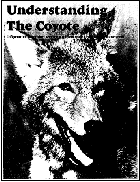Coyotes
A predator is any creature which gets some portion of its food by killing another animal. However, the concept means very different things to different people. Examples of predation include such everyday events as a swallow catching flies, a bass eating minnows, a quail catching grasshoppers and a man enjoying beef or chicken.
The sheep producer who sees a coyote kill one of his lambs is pretty certain that this particular coyote is a predator. The hunter who is fortunate enough to see a coyote catch and kill a rabbit knows that the coyote is a predator, too. In each case, the coyote has taken a creature which the man valued and perhaps desired for his own use. Often, we reserve the term "predator" for those animals which actually compete with man for prey animals.
There are many other people who view the coyote in quite a different light To many hunters, the coyote is a challenging quarry which gives many a thrilling chase. To people who simply enjoy nature, the coyote ranks as one of the most beautiful, intelligent creatures on earth. To many cattle ranchers, he is a symbol of the "Old West" and they enjoy listening to the yipping song of coyotes at sunrise and sunset. Fur trappers realize that the coyote can be a valuable furbearer. The eating habits of the coyote don't interfere with the enterprises of these men and so, to them, he is something more than a competing predator.
Coyotes are members of the dog family or Canidae and are much like dogs in many of their habits. The scientific name of the coyote, Canis latrans is Latin for "barking dog." The common name comes from the Aztec Indian word coyoti and was handed down by the Spaniards. Although the preferred pronunciation is the Mexican-Spanish version "ki-o-tee," the shortened "ki-ote" is commonly used. Coyotes are sometimes referred to as prairie or brush wolves. The true wolf or timber wolf, Canis lupus , was once found in Kansas, but has been extinct in the state since about 1905.
Coyotes are found throughout Kansas as well as most of the North American continent. In recent years they have expanded their range into all of the United States. in Kansas, coyotes are most abundant in the eastern two-thirds of the state.
Coyote Control
Fins, Fur, and Feathers episode 6: Coyote Control and Deer Production
